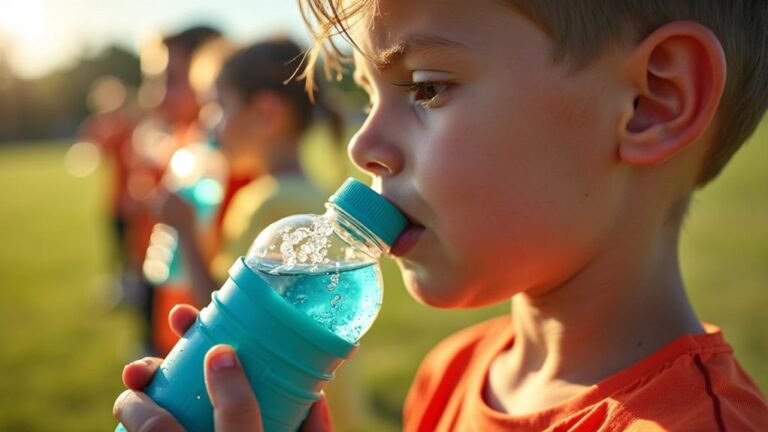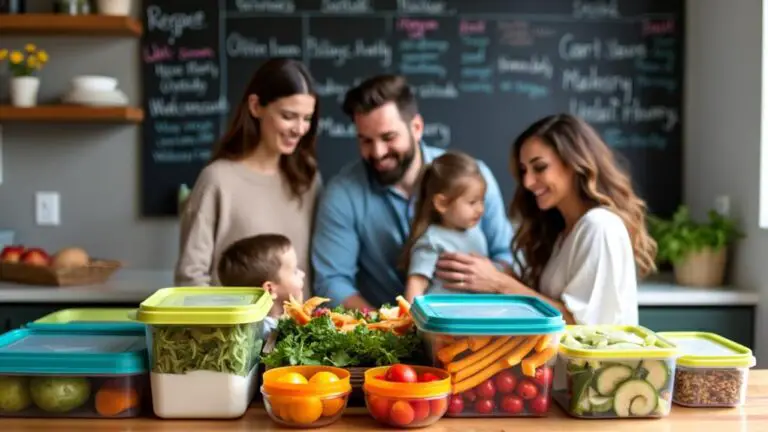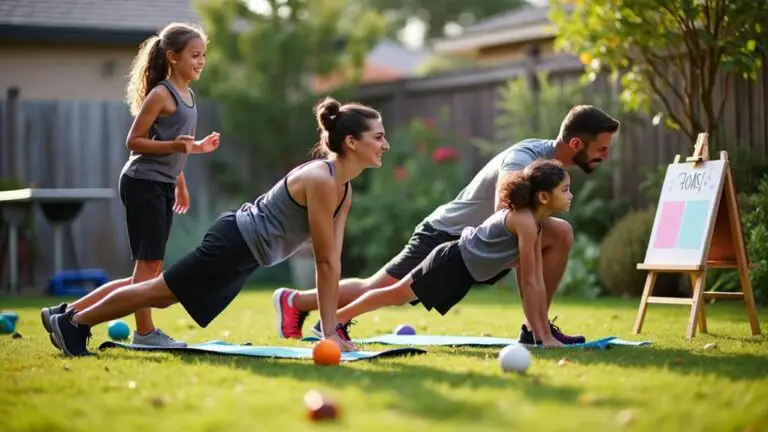Teaching Kids About Proper Food Storage and Leftovers
Teaching kids about proper food storage and leftovers is essential for their health and future independence. Start by explaining the difference between perishable and non-perishable foods, emphasizing the importance of refrigeration for perishables. Involve children in labeling leftovers with dates and show them how to use clear containers for easy identification. Teach them to recognize signs of spoilage, such as odd smells or color changes. Encourage them to help organize the refrigerator and understand safe temperature zones. Make it fun by turning storage into a sorting game. By instilling these habits early, you'll equip your kids with valuable life skills that'll serve them well beyond the kitchen.
Key Takeaways
- Involve kids in labeling and dating leftovers to teach them about food freshness and safety.
- Use clear containers to help children easily identify and organize refrigerated items.
- Teach kids about the importance of prompt refrigeration within two hours to prevent bacterial growth.
- Engage children in sorting activities to understand different food storage categories and requirements.
- Demonstrate proper reheating techniques, emphasizing the importance of reaching 165°F internal temperature.
Understanding Food Storage Basics
When it comes to teaching kids about food storage, understanding the basics is essential. Start by explaining the difference between perishable and non-perishable foods. Perishable foods like meat, dairy, and cooked dishes need to be refrigerated within two hours to prevent bacteria growth. Non-perishable items, such as canned goods and dry pasta, should be stored in a cool, dry place away from sunlight.
Teach your children about proper storage of leftovers. Use airtight containers to keep food fresh and reduce spoilage risk. Emphasize the importance of labeling containers with dates and consuming leftovers within three to four days.
Encourage kids to recognize signs of food spoilage, such as changes in odor, color, or texture. By instilling these food storage habits early, you'll help your children develop safe food practices and reduce waste in your household.
Safe Handling of Leftovers
Building on the basics of food storage, it's important to teach kids about safely handling leftovers. To prevent foodborne illnesses, refrigerate leftovers within two hours of cooking, or one hour if it's over 90°F. Use shallow, airtight containers to store leftovers, promoting faster cooling and maintaining food quality.
Label containers with dates and discard uneaten food after three to four days. When reheating, verify leftovers reach an internal temperature of 165°F to kill harmful bacteria. This step is vital for food safety.
Teach children to recognize signs of spoilage, such as odd smells or color changes, to help them identify unsafe food. By educating kids about proper leftover handling, you're empowering them to prevent cross-contamination and make informed decisions about food safety, reducing the risk of illness.
Recognizing Signs of Spoilage
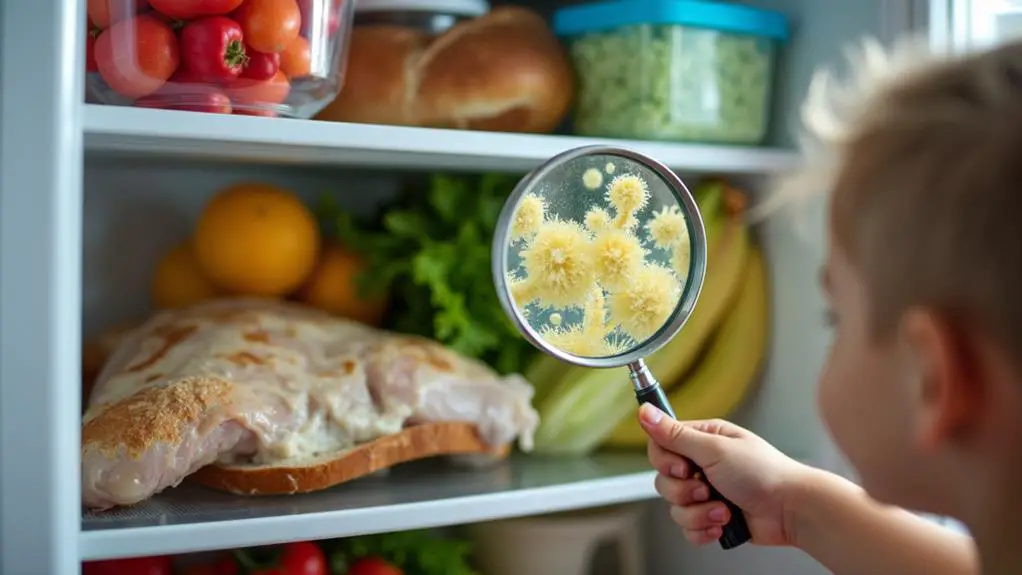
Teaching kids to recognize signs of spoilage is essential for their food safety education. You should emphasize the importance of using their senses to identify when food has gone bad.
Explain that changes in color, like browning or dark spots, can indicate spoilage. Teach them to trust their noses; a sour or off odor is a clear warning sign, especially in dairy and meats.
Show them how to spot mold growth, which appears as fuzzy or discolored patches. Describe how spoiled food may feel slimy, mushy, or too dry.
Remind them to always check expiration dates and consume leftovers within three to four days. By learning these recognizing signs of spoilage, kids can make informed decisions about proper food storage and consumption.
Don't forget to stress the importance of washing hands before handling food to prevent contamination.
Proper Refrigeration Techniques
Through proper refrigeration techniques, kids can learn to keep food safe and prevent waste. Teach them to refrigerate perishable foods within two hours of cooking or purchasing, or within one hour if it's above 90°F.
Show them how to set the refrigerator to 40°F or below and the freezer to 0°F or lower. Emphasize the importance of using shallow containers for leftovers and labeling them with dates.
Instruct kids to reheat foods to 165°F, using a food thermometer for accuracy. Demonstrate proper handwashing before handling food and explain why raw meats should be placed on the bottom shelf to prevent cross-contamination.
Engaging Kids in Storage Practices
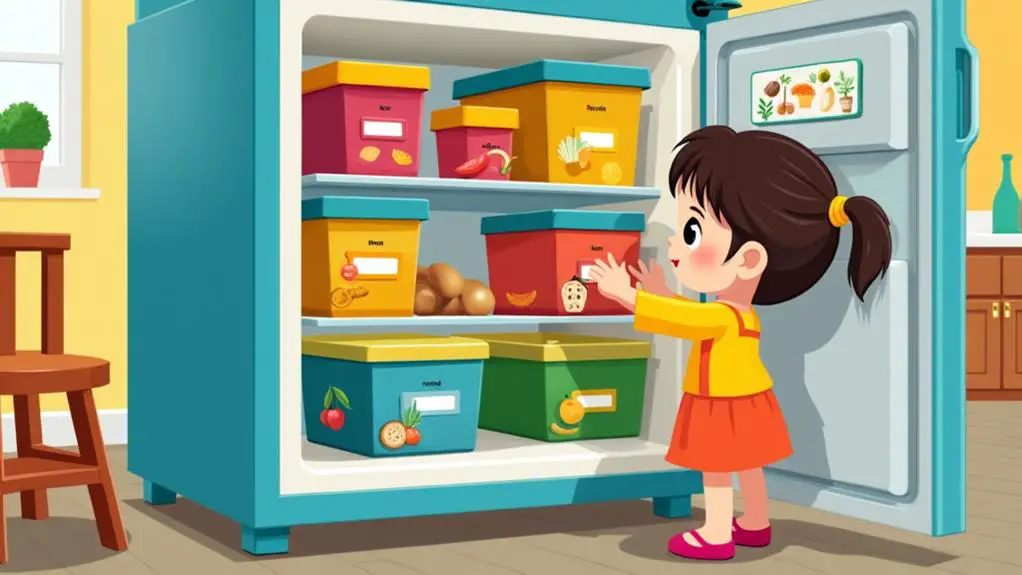
Once kids grasp the basics of refrigeration, it's time to get them actively involved in food storage practices. Teach kids valuable life skills by involving them in labeling leftovers with dates and using clear, age-appropriate containers. Encourage them to help organize the refrigerator, placing perishable items at the front and following the "first in, first out" principle to minimize food waste.
Make learning engaging by incorporating fun activities like sorting foods into categories. Here's a simple way to involve kids in food storage:
| Activity | Skill Learned |
|---|---|
| Labeling leftovers | Tracking freshness |
| Using clear containers | Identifying items |
| Organizing fridge | Minimizing waste |
| Refrigerating promptly | Ensuring food safety |
| Sorting food categories | Understanding storage |
Conclusion
You've equipped your kids with essential food safety knowledge. By teaching them proper storage and leftover handling, you're safeguarding their health and reducing waste. Remember, engaging children in these practices makes learning fun and memorable. Did you know that according to the FDA, about 48 million Americans get sick from foodborne illnesses each year? By instilling good habits now, you're helping your kids avoid becoming part of that statistic. Keep up the great work in creating food-savvy youngsters!


